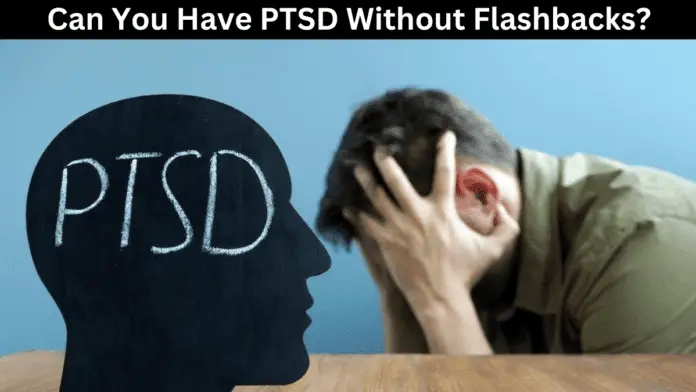
Post-traumatic stress disorder (PTSD) is a mental health condition that can develop after experiencing or witnessing a traumatic event. While flashbacks are one of the most commonly associated symptoms, many people wonder: can you have PTSD without flashbacks? In this evidence-based article, we will explore the answer to this question, backed by research, facts, and statistics.
Understanding PTSD: The Basics
PTSD is a complex mental health disorder that can affect individuals of all ages, genders, and backgrounds. It occurs when an individual experiences or witnesses a traumatic event, such as a natural disaster, war, terrorist attack, sexual assault, or serious accident. The impact of these events can lead to lasting changes in the brain’s stress response system, making it difficult for the person to cope with everyday life.
According to the American Psychiatric Association, about 3.5% of adults in the United States have PTSD, with women being twice as likely as men to develop the disorder. It is also estimated that approximately 7-8% of the population will experience PTSD at some point in their lives.
Symptoms of PTSD: Beyond Flashbacks
While flashbacks are a common and well-known symptom of PTSD, they are not the only manifestation of the disorder. Other symptoms can be grouped into four main categories:
- Intrusive thoughts: These include unwanted memories, nightmares, and flashbacks related to the traumatic event.
- Avoidance: This involves avoiding thoughts, feelings, people, or situations that remind the person of the trauma.
- Negative changes in mood and cognition: Symptoms may include feelings of guilt, shame, detachment from others, and difficulty experiencing positive emotions.
- Alterations in arousal and reactivity: This can manifest as irritability, angry outbursts, hypervigilance, difficulty concentrating, and sleep disturbances.
Can You Have PTSD Without Flashbacks?
The short answer is yes; it is possible to have PTSD without experiencing flashbacks. As mentioned earlier, PTSD has a wide range of symptoms, and flashbacks are only one aspect of the disorder. Some individuals with PTSD may predominantly experience other symptoms, such as avoidance, negative changes in mood and cognition, or alterations in arousal and reactivity.
It is essential to recognize that PTSD can manifest differently from one person to another. Factors such as the nature of the traumatic event, the individual’s personality and coping mechanisms, and the presence of social support can all influence the specific symptoms experienced by someone with PTSD. This variability underscores the importance of seeking professional help for a comprehensive assessment and tailored treatment plan.
Read: Can You Go to the ER for Anxiety?
Diagnosing PTSD: Criteria and Assessment
A diagnosis of PTSD is made based on the criteria set forth in the Diagnostic and Statistical Manual of Mental Disorders, 5th Edition (DSM-5). These criteria include:
- Exposure to a traumatic event involving actual or threatened death, serious injury, or sexual violence.
- The presence of intrusion symptoms, such as flashbacks, nightmares, or distressing memories.
- Persistent avoidance of stimuli associated with the traumatic event.
- Negative alterations in mood and cognition related to the trauma.
- Marked alterations in arousal and reactivity.
- Duration of symptoms for more than one month.
- Significant distress or impairment in social, occupational, or other areas of functioning.
- Symptoms not attributable to medication, substance use, or another medical condition.
It is important to note that while flashbacks are one of the possible intrusion symptoms, their absence does not preclude a PTSD diagnosis. A mental health professional will conduct a thorough assessment, taking into account the individual’s unique experiences and symptoms, to determine the appropriate diagnosis and treatment plan.
Treatment Options for PTSD
Effective treatment for PTSD typically involves a combination of psychotherapy, medication, and self-help strategies. Some of the most common evidence-based treatments include:
- Cognitive-behavioral therapy (CBT): CBT helps individuals identify and challenge negative thought patterns related to their trauma, promoting healthier ways of thinking and coping.
- Prolonged exposure therapy: This form of therapy involves gradually confronting and processing traumatic memories in a safe and controlled environment, reducing avoidance behaviors and emotional distress.
- Eye movement desensitization and reprocessing (EMDR): EMDR combines elements of exposure therapy and cognitive therapy, using eye movements or other bilateral stimulation to help process traumatic memories.
- Medication: Antidepressants, anti-anxiety medications, and sleep aids may be prescribed to help manage PTSD symptoms and improve overall functioning.
In addition to professional treatment, self-help strategies such as exercise, mindfulness practices, and social support can play a crucial role in recovery from PTSD.
FAQs
Q: Can you have PTSD without flashbacks?
A: Yes, it is possible to have PTSD without experiencing flashbacks. PTSD has a wide range of symptoms, and flashbacks are only one aspect of the disorder. Other symptoms may be more prominent for some individuals.
Q: What are the main symptoms of PTSD?
A: PTSD symptoms can be grouped into four main categories: intrusive thoughts, avoidance, negative changes in mood and cognition, and alterations in arousal and reactivity.
Q: How is PTSD diagnosed?
A: PTSD is diagnosed based on the criteria set forth in the DSM-5, which include exposure to a traumatic event, the presence of specific symptoms, duration of symptoms, and significant distress or impairment in functioning.
Q: What are the treatment options for PTSD?
A: Treatment for PTSD typically involves a combination of psychotherapy, medication, and self-help strategies, with evidence-based approaches such as cognitive-behavioral therapy, prolonged exposure therapy, and eye movement desensitization and reprocessing being particularly effective.
Conclusion
In conclusion, while flashbacks are a common symptom of PTSD, it is possible to have the disorder without experiencing them. A thorough assessment by a mental health professional is necessary to determine the appropriate diagnosis and treatment plan, taking into account the individual’s unique experiences and symptoms.












